Contents
Raspberry Didimella is a dangerous disease caused by the fungus Didymella applanata Sacc. Penetrating into large and small cracks on the branches and roots of raspberries, purple spotting (another name for didimella) very quickly affects all vegetative parts of the plant, causing a deterioration in its general condition.
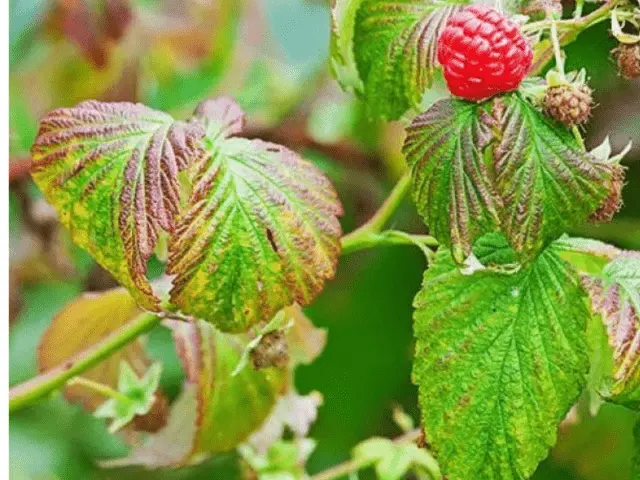
Raspberry didimella spoils the appearance of the plant
Purple Spot Symptoms
With the onset of heat, the spores of the fungus that have overwintered in the bark of raspberries or under a layer of fallen leaves wake up and, moving to the bushes, begin their pest activity. First, the symptoms of didimella appear on the stems of the plant, and then on its leaves.
On stems
You can determine the presence of didimella by changing the appearance of raspberry shoots:
- small bluish spots form at the base of the stem, which, rapidly increasing in size, after a while cover its entire surface;
- there is a total defeat of the branches, which along the entire length are covered with a bluish bloom;
- at the breeding sites of spores, small cracks appear on the bark, gradually increasing in size;
- past shoots dry out ahead of time and die.
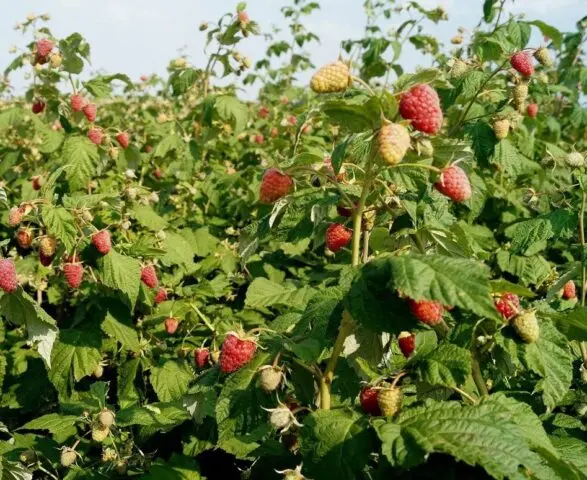
Didymella diseased stems change color
On the leaves
Having moved to the foliage of raspberries, didimella manifests itself as the appearance of small white-brown specks. Growing, they merge into large and small spots – brown or crimson in the middle and rusty at the edges. The leaves affected by the fungus gradually dry up and die.

It is difficult not to notice the leaves affected by didimella
Causes of the disease
The cause of infection of raspberries with didimella fungus can be:
- increased air humidity combined with a decrease in air temperature below +20 °С;
- density of landings;
- an excess of nitrogen in the soil;
- the presence of growths formed by gall midges;
- proximity to groundwater;
- stagnation of moisture on the soil surface during the rainy season or as a result of improper watering.
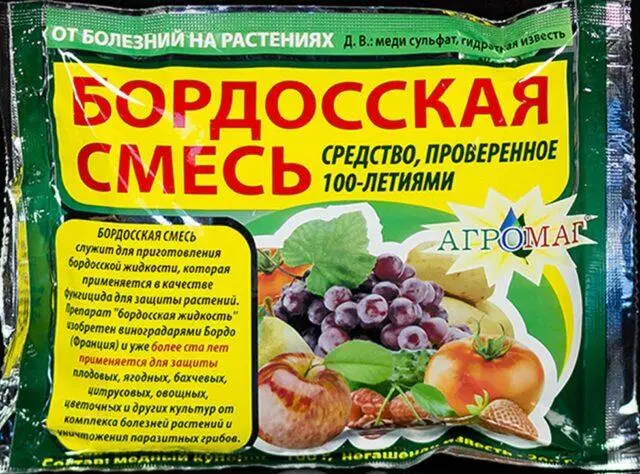
Close planting makes it difficult for oxygen to reach plants.
What is dangerous didimella
A fungal infection spreading at high speed quickly covers the entire plant, which causes disruption of vegetative processes, and sometimes the death of raspberry bushes.
As a result of the development of didimella:
- the plant becomes weak and vulnerable to other infections;
- slows down, and after a while the formation of new shoots stops;
- the root system is damaged, as a result of which the raspberry does not receive enough nutrition and dies;
- berries dry up at the ovary stage.
Didimella is especially dangerous in combination with the activity of the gall midge (raspberry mosquito) – a harmful insect that climbs into cracks on raspberry branches formed as a result of the disease and lays eggs there.
After some time, thickenings filled with larvae form in such places, which are called gall midges. Simultaneous exposure to didimella and raspberry mosquito with a high degree of probability can lead to the death of the bush.

The presence of gall midges can be diagnosed by the characteristic cones on the stem.
Can it move to other bushes
During sporulation, the infection quickly spreads throughout the raspberries, and if emergency measures are not taken, didimella will infect other bushes, affecting an increasing area.
Didimella spores can move:
- through the air with the wind;
- with water when watering;
- on the legs of insects during pollination
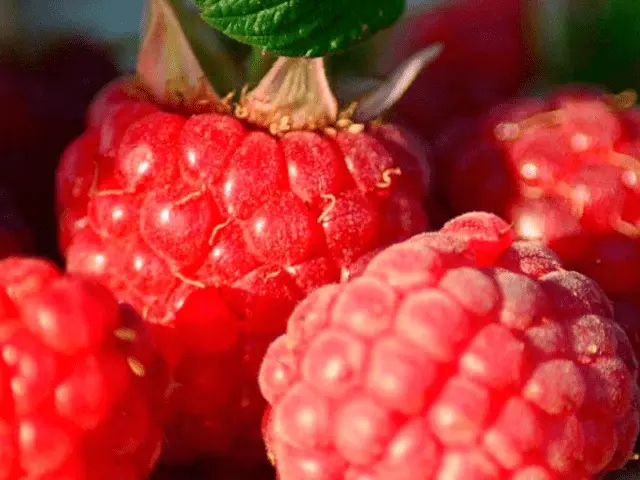
Bees can become carriers of infection
Treatment for purple spotting on raspberries
Purple spotting is not treatable, but it can be stopped from spreading.
To do this, first of all, all infected shoots and leaves are removed, and then they are burned away from the raspberries. Care must be taken to ensure that not a single diseased branch remains. Otherwise, the effectiveness of treatment will be zero.
You can also not use the cut parts of raspberries for composting. The spores of the fungus will thrive in the moist environment of the compost pit, and it is likely that in the spring with a dose of organic fertilizer they will again fall into the raspberry tree.
To prevent infection of other plants, experts recommend spraying raspberries from purple spotting with one of the chemicals.
Urea
Raspberries are sprayed with an aqueous solution of urea twice with an interval of 15 days. For the first treatment, 700 g of a dry preparation is poured into 10 liters of pure water and thoroughly mixed until the urea is completely dissolved.
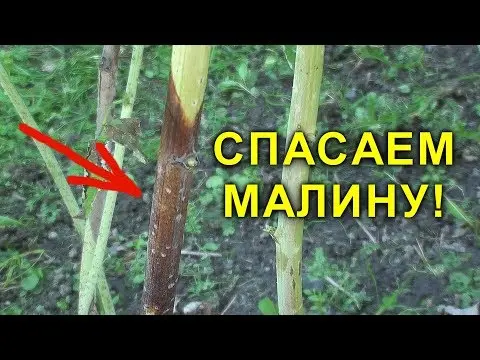
It is better to spray the shoots in dry calm weather
After opening the buds, raspberries are sprayed with a solution prepared at the rate of 50 g of urea per 10 liters of water.
Bordeaux liquid
The drug can be bought ready-made in the store or made by dissolving 100 g of copper sulfate and the same amount of quicklime in 10 liters of water.
For preventive purposes, raspberries are treated with 1% Bordeaux liquid three times a year: at the stage of leaf formation, during the budding period, and also after picking berries.
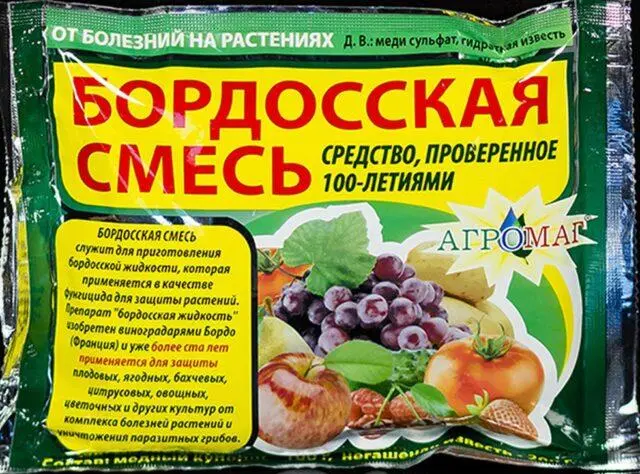
Bordeaux mixture is non-toxic and harmless
Kuproksat
To prepare a working solution, 50 ml of the drug is diluted in a bucket of clean water. Raspberries are processed with the prepared composition in two steps.
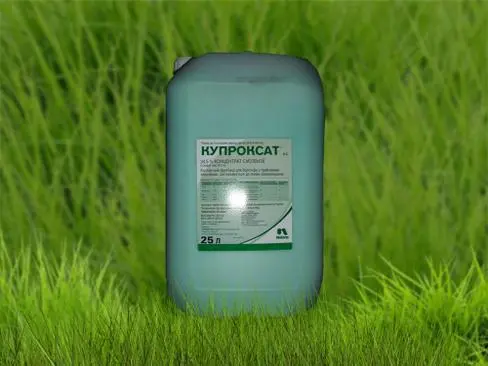
The recommended time interval between sprayings with Kuproksat is two weeks.
Topaz
With this solution, prepared at the rate of 15 g of the drug per 10 liters of water, raspberries are treated immediately after sanitary pruning. The procedure is recommended to be repeated two weeks after the first spraying.
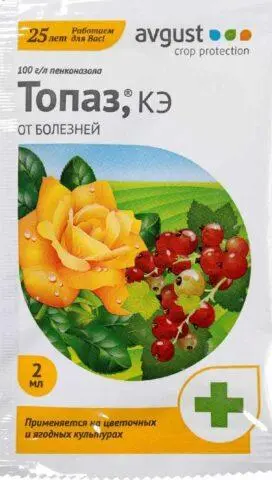
Topaz should not be used during fruiting
Fundazole
20 g of the drug is dissolved in a bucket of water and the plants are sprayed with it after sanitary pruning. The next time the treatment is carried out after 15 days.
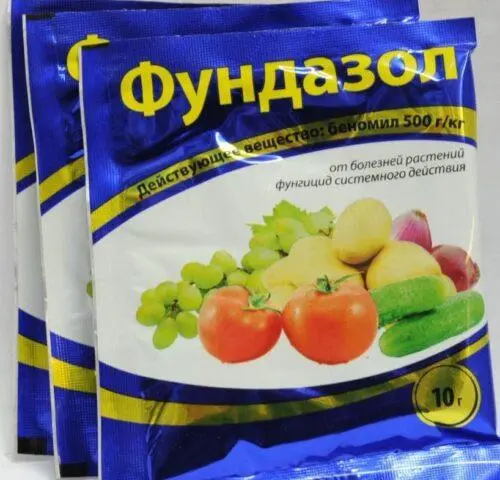
Timely treatment of didimella with Fundazol will help save the crop
Raspberry Varieties Resistant to Purple Blight
Unfortunately, breeders have not yet bred raspberries that are absolutely resistant to didimella. However, there are many cultivars with good resistance to purple blotch.
You can reduce the likelihood of damage to the bushes by the didimella fungus by planting raspberries of the following varieties on your site:
- Bryansk;
- brigantine;
- Newburgh;
- September;
- Julia;
- Modest;
- News of Mykolaichuk;
- Balm;
- Glenn Mow;
- Companion;
- Kuzmin’s news;
- Chief;
- Latam;
- Malling Leo.
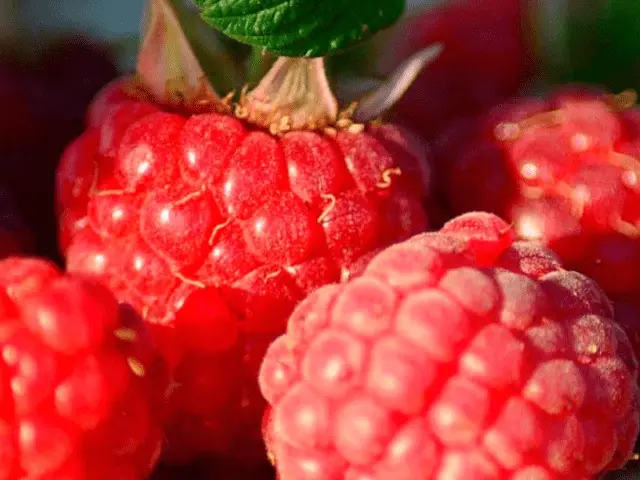
Raspberry Companion practically does not get sick with didimella
preventive measures
Any disease, including raspberry didimella, is easier to prevent than to treat. Given the high viability of the spores of this fungus, the prevention of the disease should be taken as responsibly as possible.
To exclude the development of purple spotting on the branches and leaves of raspberries will help:
- Cultivation of varieties with immunity to this disease.
- Use of quality planting material. Healthy seedlings are strong and flexible, they cannot be cracked or stained.
- Choosing a suitable site for growing raspberries. Acidic soil combined with dampness and shade are ideal conditions for the development of didimella.
- Organization of proper watering – raspberries equally do not like both the lack of water and its excess. In the first case, the bushes will lose their vitality and dry out, and in the second, there is a high probability of developing fungal diseases, including didimella.
- Regular top dressing – a lack of nutrients in the soil leads to a weakened immunity in raspberries, as a result of which the risk of infection with didimella increases.
- Regular thinning of plantings to ensure normal ventilation of the bushes. High humidity with a close arrangement of shoots is an excellent breeding ground for the fungus.
- Growing raspberries on trellises helps ensure oxygen access to all parts of the plant and reduces the likelihood of developing disease.
- Loosening the topsoil in spring and autumn. This contributes to the destruction of most of the pathogenic microorganisms hibernating in it.
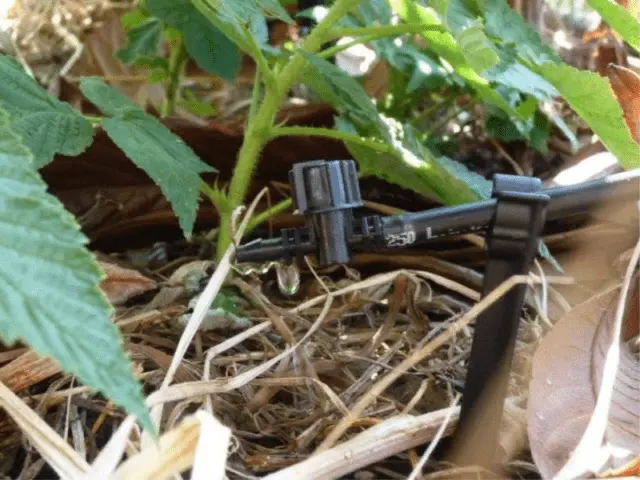
Ideal irrigation option – drip
Conclusion
Raspberry didimella is a serious disease that can destroy an entire plantation in one season. Only thanks to competent prevention, as well as timely detection of signs of the disease and treatment, it is possible to grow healthy bushes and get a good harvest of ripe juicy berries.









